- Real gross domestic product (GDP)
- Cost-competitiveness
- Natural resources sustainability
- Climate change
- Green economic practices
- Forest cover (supplemental indicator)
- Soil quality (supplemental indicator)
- Contribution of renewables to energy supply (supplemental indicator)
- Energy production and use (supplemental indicator)
Real GDP
Current performance and trends
In 2003 Canada experienced an economic slowdown, reflecting a series of economic shocks, including an unprecedented
appreciation of the Canadian dollar. Rebounding in 2004, real GDP rose 2.9áper cent, surpassing the 2.0áper cent
recorded in 2003. The Organisation for Economic Co-operation and Development
(OECD) predicted growth of 2.8áper cent in 2005 for Canada's economy, the second highest growth among G-7 members
behind the U.S., whose predicted growth for 2005 stands at 3.6áper cent (OECD, Economic Outlook No.77, May
2005). Canada led the G-7 in terms of growth over the period of 2000-03 and is expected to remain a top performer,
second only to the U.S., for 2004-06.

On a per capita basis, real GDP growth strengthened to 2.0áper cent in 2004 from 1.1áper cent in 2003. Within the
G-7, Canada had the second fastest growth in real GDP per capita between 2000 and 2004, second to the United Kingdom.
Among Canadian provinces and territories, real GDP per capita growth in 2004 was strongest in Saskatchewan, followed by
British Columbia, the Northwest Territories, and New Brunswick.
In 2004, five provinces and territories recorded economic growth that was above the national average, most of them
in western Canada. Newfoundland and Labrador was the only province with a decline in real GDP, primarily due to
production problems on the Terra Nova oil platform and strikes in the public service and mining industries.
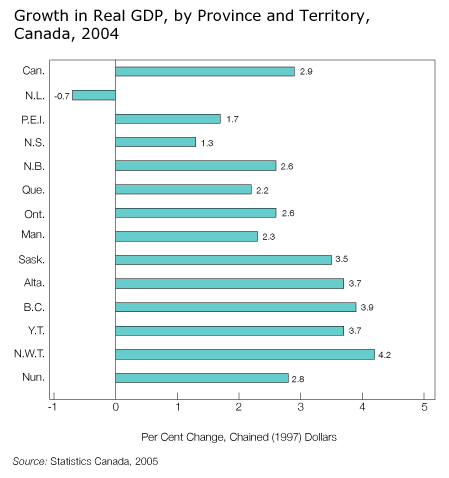
Additional information: Regional economic growth
Atlantic provinces
In 2004 New Brunswick's economic growth of 2.6áper cent was influenced by the manufacturing sector's 3.6áper cent
recovery, which was led by increasing shipments of primary metal products. Although Newfoundland and Labrador saw an
overall decline of 0.7áper cent, the province experienced strong growth in residential construction, with a
12.0-per-cent increase, largely due to the greatest number of housing starts since the early 1990s. Prince Edward
Island's economic growth of 1.7áper cent equalled their achievement in 2003. Factors contributing to the rise included
an increase in manufacturing, such as production of frozen food products, and a strong housing market. Home building,
the manufacture of rail cars and high tech equipment, and strong retail trade spurred the expansion of the Nova Scotia
economy by 1.3áper cent.
Ontario and Quebec
Economic growth in Ontario for 2004 stood at 2.6áper cent, slightly below the national average. Transportation
equipment manufacturing and wholesale trade and finance contributed significantly to growth of economy, whereas gains
in personal consumption and business investment were below national average. Quebec's economic growth was also below
the national average, at 2.2áper cent. There was strong investment, however, in housing, with a 15.0-per-centáincrease
in 2004, which, in turn, stimulated sales of furniture, appliances, and building materials. Aerospace production fell
9.2áper cent as a result of a weak demand for new aircraft.
Western Canada
Saskatchewan experienced strong growth with a rise of 3.5áper cent, supported by a significant increase in the
manufacturing sector (11.5áper cent) related to providing machinery for a strong petroleum industry. In addition, meat
processors increased production to deal with surplus cattle due to closure of the U.S. border to Canadian beef.
Alberta's overall growth of 3.7áper cent was spurred by the same factors as that of Saskatchewan, as well as
increased activity in the oil patch. An increase in consumer spending of 4.7áper cent and low unemployment at 4.6áper
cent also contributed to Alberta's positive economic picture for 2004. A 4.1-per-cent increase in consumer spending and
low unemployment contributed to British Columbia's strong economic performance, as did 15.0-per-cent improvements in
forestry and sawmill production and output of coal.
Economic growth of 2.3áper cent for Manitoba was hampered somewhat by a weak agriculture sector. Home building
sustained the manufacture and sale of furniture and construction materials, however, and electricity production and
exports were spurred by favourable weather conditions in 2004.
The territories
With growth of 3.7áper cent, Yukon's best economic performance in three years was caused by strong growth in all
sectors, particularly business and government investment. Led by gold, the mining industry saw an increased output of
70.0áper cent in 2004. The Northwest Territories experienced economic growth of 4.2áper cent in 2004, half of which can
be attributed to the diamond mining industry. The year 2004 saw significant improvement for the economy of Nunavut,
with 2.8áper cent growth, recovering from a 7.6áper cent decline in 2003. Increases in business investment played a
considerable role, as mine closures over the last 10 years have reduced the mining industry to one tenth of its size in
2000. (Statistics Canada, Provincial and Territorial Economic Accounts Review-Preliminary Estimates 2004,
2005)
Current performance and trends
The comparison of business costs demonstrates the advantages of locating business operations in Canada. Lower costs
encourage the investment, expansion, or start of businesses in Canada. Costs related to labour, transportation,
communications, and taxes were some of the factors considered in a 2004 international study of cost advantage published by KPMG.
In all of the 17 industries surveyed, Canada ranked first in the G-7 for cost-competitiveness. For example, Canada
led the way in cost-competitiveness for the aerospace, telecommunications, and biotechnology industries. Overall
Canada's labour costs were among the lowest, as were costs associated with facilities, utilities, and taxes.
Canada has a 9.0-per-cent cost advantage relative to the U.S. (the baseline of the study), down from 14.5áper cent
in 2002. According to the study, the decline in the U.S. dollar relative to world currencies was the most important
factor affecting international business competitiveness since 2002. Exchange rates for the countries profiled in the
study appreciated by between 9.0 and 35.0áper cent relative to the U.S. dollar since 2002.
Additional information: Cost-competitiveness by industrial
sector
Manufacturing
In the manufacturing sector-represented by seven operations, including metal machining, electronics assembly, and
pharmaceutical products-Canada led the way with a 6.0-per-cent cost advantage. In the aerospace industry, which
produces commercial and military aircraft and parts, military weapons, space rockets, and satellites and was
represented in the survey by aircraft parts manufacturing, Canada's industry had the highest after-tax profits and the
lowest total annual costs-a result repeated in the telecommunications industry. The telecommunications industry
includes traditional wireline networks, optical, and wireless access technologies. For the representative operation in
this industry, telecom equipment manufacturing, Canada is home to 4áof the 5 top cities for cost-competitiveness ranked
among 98 around the world: St. John's, Sherbrooke, Moncton, and Halifax.
Research and development and corporate services
Canada also had the best results in the research and development (R&D) and corporate services sectors, with
21.0-per-cent and 11.7-per-cent cost advantages respectively. The R&D sector includes the biotechnology industry,
whose applications include such diverse fields as medical testing, environmental management, and DNA fingerprinting.
The biotechnology industry, represented in the survey by biomedical R&D, was modelled on a research facility with
no commercial sales and characterized by significant investment in R&D equipment, a workforce of research
scientists and technicians, and a significant level of tax-eligible R&D activities. Canada had the second highest
after-tax profit and lowest total annual costs.
The corporate services sector was represented by the operation of shared services centres, which are those that
include centralized accounting, customer call centres, and internal information technology support functions. These
centres function to support business operations through telephone and electronic communication and are characterized by
a workforce of administrators, clerks, and help desk agents. Canada had the lowest total annual costs for this
corporate service sector operation, as well as 4 of the top 5 cities for cost competitiveness ranked among 98 around
the world: Sherbrooke, Charlottetown, Halifax, and St. John's.
Current performance and trends
In 2004 the status of commercial fish stocks did not change significantly. Among the 70ástocks assessed, no
notableáchange occurred as compared with their status from 2001 to 2003. Among 102 commercial fish stocks assessed
between 2001 and 2003, 36ástocks were healthy and increasing; 22áwere healthy and stable; and 44 were declining or
depleted and not yet recovered, as compared with their status in the early 1990s. As a result of their assessment
schedules, the North and Pacific salmon stocks are under-represented and therefore this is not a balanced
representation of all Canadian fish stocks. For additional information on the status of fish, invertebrate, and marine
mammal stocks, environmental and ecosystem overviews, see the Canadian Science Advisory Secretariat Web site
at http://www.dfo-mpo.gc.ca/csas/Csas/Home-Accueil_e.htm.
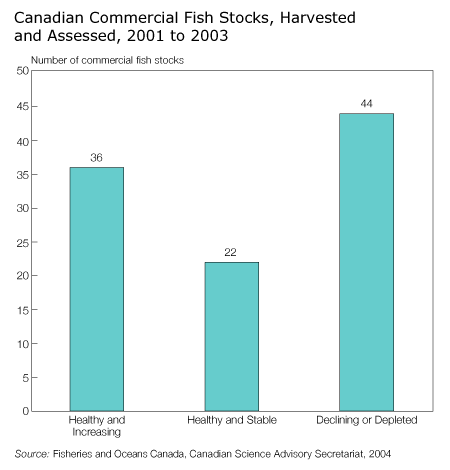
Additional information: Agriculture and the
environment
For a list of publications on agriculture and the environment, go to http://www.agr.gc.ca/policy/environment/publications_e.phtml.
Additional information: State of Canada's
forests
Go to the Canadian Forest Service Web site, http://www.nrcan-rncan.gc.ca/cfs-scf/index_e.html, where you will find information on
the state of Canada's forests for 2003-04.
Current performance and trends
Since 1990, Canadian greenhouse gas (GHG) emissions have risen by 24.0áper cent, steadily increasing the distance
from Canada's Kyoto targets. From 2002 to 2003, emissions increased by 3.0áper cent, mainly due to a
colder-than-average winter, coupled with increases in electricity production, vehicle transport, and mining activity.
In 2003, Canadians contributed approximately 740ámegatons of CO2áequivalent of GHGs into the atmosphere,
equating to about 2áper cent of total global GHG emissions. Canada's overall GHG emissions intensity-the amount of GHGs
emitted per unit of economic activity-was 1.2áper cent higher in 2003 than in 2002. The long-term trend for Canada's
emissions intensity, however, shows a steady decline by an average of 1.0áper cent per year since 1990.
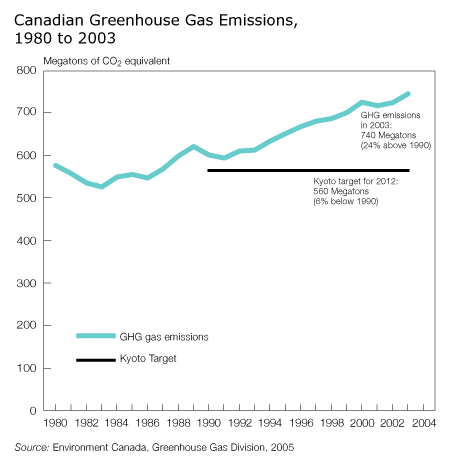
A breakdown of GHG emissions by industry sector has found that in 2003 the energy production and use sector
accounted for 80.0áper cent of the total GHG emissions produced. Upon further analysis, this sector has accounted for
90.0áper cent of the overall growth in Canada's emissions between 1990 and 2003.
Current performance and trends
According to Energy Efficiency Trends in Canada, a report by The Office
of Energy Efficiency, Canada's secondary energy use increased by 22.0áper cent between 1990 and 2003. This was
primarily due to growth in economic activity in each end-use sector. For example, activity in the industrial sector
increased by 45.0áper cent during this period. Had it not been for significant ongoing improvements in energy
efficiency, the increase would have been another 13.0áper cent, or 883.3ápetajoules, higher (1ápetajoule is the amount
of energy consumed by a town of 3,700ápeople in one year).
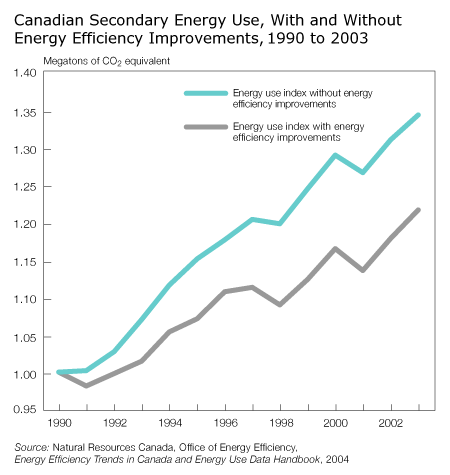
According to a recent International Energy Agency report, Canada's energy efficiency improved at an average annual
rate of 1áper cent between 1990 and 1998, similar to the rate recorded by the U.S., and the fourth fastest rate of
improvement among the 13 countries included in the report (surpassed only by Finland, Italy, and Norway).
Current performance and trends
A sustainable economy calls for the integration of environmental considerations into economic decision making and
can be measured by the number of firms certified with the environmental management system ISO 14001. The number of
certifications to the international environmental management standard ISO 14001 is often used as an indicator of a
country's development in the use of voluntary environmental agreements and is understood as a form of country-level
environmental performance indicator. The number of Canadian firms with ISO 14001 certification increased from 100 in
1999 to 1,484 in 2004, moving Canada from 21st to 12th in world rankings.
International comparison
Consideration of the size of a country (measured by population) and its level of economic development (measured by
GDP) should be taken into account when using ISO 14001 certification as a measure of green economic practices, as these
provide context in which to judge a country's environmental management development.
Canada's international ranking ranges from 33rd in 1999 to 19th in 2001 and 27th in 2003 when taking into account
the level of Canada's economic development. When factoring in Canada's size, Canada's 2003 ranking is unchanged from
22nd in 1999, with its highest ranking of 15th occurring in 2001. For both measures in 2003, Canada places second last
within the G-7, ahead of only the U.S. Globally, since 1999 Sweden has held the top ranking when economic development
and country size are considered, with Switzerland, Denmark, and Finland also consistently in the top five.
Additional information: Environmental management
systems
Current performance and trends
Forests are sites of wood production, habitat for wildlife, and a source of ecological services, such as clean air
and sequestration of carbon. According to the Canadian Forest Service, approximately 1ámillion hectares of forest are
harvested annually, supporting a more than $80-billion industry. These economic and ecological goods and services
provided by forests therefore demand sustainable management practices. Tracking changes in size of Canada's forests is
one way of evaluating performance, and this can be done by measuring the area of forest with 10.0-per-cent crown
closure, a level accepted by the Food and Agriculture Organization of the United Nations as constituting forest. Crown
closure is the percentage of the ground surface that would be covered by a downward vertical projection of the foliage
in the crowns of trees. Using satellite imagery data for 1998 that show crown closure for each square kilometre (100
hectares), forest cover in Canada is 392.0ámillion hectares. This does not include forest stands outside the
traditional northern forest boundary. It is important to note that while forest cover does not equal forest health, it
does give overall view of the extent of forest ecosystems in Canada. Because satellite data are only available for
1998, forest cover will become a more useful indicator once additional data are collected and are compared with field
data and it is possible to observe temporal trends. (National Round Tableáon the Environment and the Economy, 2003)

Temporal trends-The National Forest Inventory
Comparisons over time are of major importance to answering questions on the sustainable development of Canada's
forest. Canada's Forest Inventory (CanFI) has been compiled periodically by aggregating provincial management and other
source inventories. A new National Forest Inventory (NATINV) design has been developed and is being implemented in
co-operation with the provinces and territories. The new design addresses the need to track changes such as land cover,
forest area, and volumes, as well as supporting additional forest resource information. The first report with the new
inventory is expected by 2007. Instead of a periodic compilation of existing information from across the country, the
approach used in CanFI, NATINV consists of permanent observational units. Through the collection and reporting of
information to a set of uniform standards, it allows for consistent reporting across the country on the extent and
state of Canada's land base to establish a baseline of where the forest resources are and how they are changing over
time. In addition to providing consistent estimates for traditional forest inventory attributes, the NATINV will
provide a framework for collecting additional data relevant to the reporting of progress toward sustainable development
(e.g.ásocio-economic indicators), as well as data related to forest health (e.g. insect damage, disease infestation),
biodiversity, and forest productivity. (Canadian Forest Service, http://www.nrcan.gc.ca/cfs-scf/index_e.html)
Current performance and trends
In the context of agriculture, soil quality (or soil health) is the soil's fitness to support crop growth without
resulting in soil degradation or otherwise harming the environment. Soil degradation, as might result from erosion or
loss of organic matter, can ultimately reduce crop quality and yield and is therefore a concern for all agricultural
regions of Canada. Moreover, agricultural soils also benefit society, for example, by providing wildlife habitat,
retaining and filtering water, and sequestering carbon, thus helping to mitigate the greenhouse effect.
Agricultural production has the potential to accelerate the soil degradation processes through various land uses and
management practices, hastening the symptoms and effects of natural processes such as soil erosion. Other agricultural
land uses and management practices (such as conservation tillage methods) can, however, help stabilize or improve soil
quality. In recent decades, globalization, market pressures, and technological innovations have spurred Canadian
agriculture to increase output and productivity. This has engendered structural changes in the industry, characterized
by the adoption of new technologies and a gradual shift toward larger, more intensified operations. This, in turn, has
raised concerns about the possible effect of food production on the environment-including soil quality.
Indicators used to assess soil quality include soil erosion by water, wind, and tillage; the rates of change in soil
carbon content; and change in soil salinity on the Prairies. Results for all of these indicators show that considerable
improvements have occurred between 1981 and 2001, including the indicator that is highlighted here: the risk of water
erosion.
Rainfall and surface runoff are the driving forces for water-induced erosion, contributing to large soil losses from
farm fields over time, as well as soil degradation. Eroded soil is carried in runoff to agricultural drains, ditches,
and other waterways, where it can affect water quality. In addition, crop nutrients, pesticides, and bacteria are often
attached to the eroding soil particles and so are also carried into water bodies, adding to the effects on water
quality. The risk of water erosion identifies areas at risk of significant water erosion and assesses how this risk is
changing over time under prevailing management practices. This risk is expressed as five classes: very low (less than
6átons of eroded soil per hectare per year), low (6 to 11átons per hectare per year), moderate (11áto 22 tons per
hectare per year), high (22 to 33 tons per hectare per year) and very high (greater than 33 tons per hectare per year).
Areas in the very low risk class are considered, under current conditions, able to sustain long-term crop production
and maintain agri-environmental health. The other four classes represent the varying risk of unsustainable conditions
that would require soil conservation practices to support crop production over the long term as well as to reduce
effects on water quality. In 2001, 86.0áper cent of Canadian cropland was in the very low (tolerable) water erosion
risk class, up by 8.0áper cent from the 1981 level.
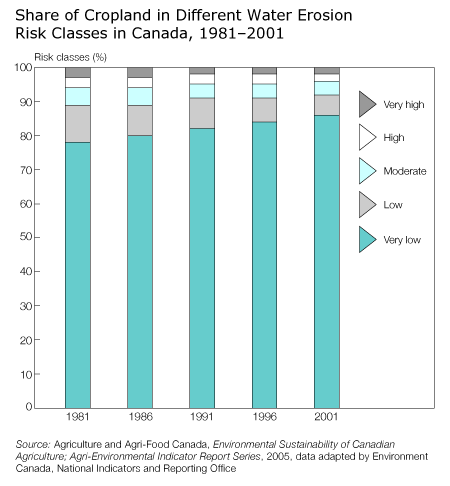
For further information on the definition and measurement of these indicators, please visit http://www.agr.gc.ca/env/naharp-pnarsa/.
Contribution of renewables to energy supply (supplemental indicator)
Current performance and trends
Reducing reliance on fossil fuels-a finite source of energy that is a major contributor to acid rain, poor air
quality, and climate change-is one course of action for strengthening green economic practices. Viable alternatives
include renewable energy sources such as hydro, solar, and wind energy. Renewable energy sources are those that produce
electricity or thermal energy without depleting resources. Renewable energy does, however, have negative environmental
impacts, such as making large tracts of land unusable for competing uses; the disruption of marine life, bird life, and
flora and fauna; and the production of visual and noise pollution. (Natural Resources Canada, 2005; International
Energy Agency, Renewable Energy, 2002)
Between 1994 and 2003, the contribution of renewables to energy supply (as a percentage of total primary energy
supply) in Canada ranged from 15.8áper cent in 2001 to a high of 17.0áper cent in 1996, with the most recent figure of
16.3áper cent in 2003. In contrast, other G-7ácountries figures ranged from 1.4áper cent in the United Kingdom to
6.4áper cent in France in 2003. (OECD, Factbook 2005: Economic, Environmental and Social Statistics, 2005) For
further information on renewable energy in Canada, consult Natural Resource Canada's Canadian Renewable Energy Network
at http://www.canren.gc.ca.
Current performance and trends
According to the World Bank publication World Development Indicators 2004, high-income countries, with
15.0áper cent of the world's population, use more than five times as much energy as low- and middle-income countries on
a per capita basis.
The World Bank defines total energy production as "forms of primary energy-petroleum (crude oil,
natural gas liquids, and oil from nonconventional sources), natural gas, and solid fuels (coal, lignite, and other
derived fuels)-and primary electricity, all converted to oil equivalents." Energy use refers to
"apparent consumption, which is equal to indigenous production plus imports and stock changes, minus exports and fuels
supplied to ships and aircraft engaged in international transport."
Energy Production and Use, G-7 1990 and 2001
| á |
Total Energy Production (thousands
metric tons of oil equivalent) |
Energy Use (thousands metric tons
of oil equivalent) |
Energy Use per Capita (kg of oil
equivalent) |
| á |
1990 |
2001 |
1990 |
2001 |
1990 |
2001 |
| Canada |
273,680 |
379,207 |
209,020 |
248,184 |
7,524 |
7,985 |
| France |
111,278 |
132,709 |
227,114 |
265,570 |
4,003 |
4,487 |
| Germany |
186,157 |
133,745 |
356,218 |
351,092 |
4,485 |
4,264 |
| Italy |
25,547 |
26,264 |
152,552 |
171,998 |
2,690 |
2,981 |
| Japan |
73,209 |
104,006 |
436,523 |
520,729 |
3,534 |
4,099 |
| UK |
207,007 |
261,939 |
212,176 |
253,158 |
3,686 |
3,982 |
| U.S. |
1,650,408 |
1,711,814 |
1,927,572 |
2,281,414 |
7,728 |
7,996 |
Source: World Bank, World Development Indicators, 2004
Examining the differences between energy production and energy use, Canada was the only G-7 country whose production
exceeded its use, with the exception of the United Kingdom in 2001. Germany was the sole G-7 country to reduce both
production and use of commercial energy between 1990 and 2001. Canada had the second highest commercial energy use per
capita, closely following the U.S., consuming approximately more than double the quantities of each of the remaining of
the G-7 countries. (World Bank, World Development Indicators 2004: 140-43)
According to the Canadian Economic Observer (Statistics Canada, Aprilá2005), "energy (has) consolidated its
place as Canada's leading resource export" and "Canada's surplus in trade in energy is now almost as large as all other
resource exports combined." Moreover, "energy exports have doubled since 1999, driven by higher prices and new sources
of supply."
- Innovation
- Educational attainment
- Literacy
Current performance and trends
Canada's Gross Domestic Expenditures on Research and Development (GERD) as a percentage of GDP was 1.89áper cent in
2004, continuing a downward trend from 2.05áper cent in 2001. It is increasingly important for Canada to be
competitive with other countries that are aggressively increasing their GERD, such as Finland, Iceland, and Japan, all
of which by 2002 exceeded 3áper cent GERD as a percentage of GDP following steady increases since the early 1990s.

Additional information: GERD
After a decrease in 2002, increases in GERD are reported for 2003 and 2004, with a gain of 4.1áper cent in 2003 and
estimates of an additional 5.1áper cent in 2004 to reach a total of $24.5ábillion. In 2004, government funded 25.1áper
cent of GERD, a figure that represents an overall gain since 1998, when the government share was 21.6áper cent. This is
more than an 8.0-per-cent decrease from 1991, however, when government financed 33.8áper cent. In contrast,
industry-financed GERD has increased since 1991, growing from 38.2áper cent to 46.2áper cent in 2004.
Performance of GERD
In terms of performance of GERD for 2004, industry performed 51.2áper cent, higher education 38.1áper cent, and
government 10.4áper cent. The business enterprise sector's performance share has decreased from 1998 when it was
60.2áper cent, though the 2004 figure represents an increase since 1991 when it was 49.7áper cent. Higher education's
performance share of GERD has increased since 1998, from 27.2áper cent in 1998. Government-performed GERD has decreased
since 1991, when it was 18.7áper cent. Budget 2005 notes that Canada ranks among the top five nations in terms of
publicly performed research (universities, research hospitals, and government laboratories) as a proportion of GDP.
R&D intensity
In 2003, the top three industries for R&D intensity, as measured by R&D spending as a percentage of GDP,
were scientific research and development services, communications equipment manufacturing, and health care and social
assistance services.
R&D workforce
Between 1991 and 2002, the total number of researchers in Canada increased from 67,080 to 112,630. Per thousand
total employment, there were 5.1 researchers in 1991 and 7.2 in 2002. The R&D sector as a whole had a workforce of
177,120 in 2002 or 11.3ápersonnel per thousand total employment. (Statistics Canada, 2005; OECD, 2004)
For further information on GERD, see the OECD Factbook 2005: Economic, Environmental and Social
Statistics, which can be accessed on the OECD Web site at http://www.oecd.org/home.
Innovation: Triadic patent families
Current performance and trends
Shares in triadic patent families are used to measure a country's inventive performance, diffusion of knowledge, and
innovative activities. Canada's world share in triadic patent families among the OECD countries grew slightly from
1.09áper cent in 1995 to 1.18áper cent in 2001, peaking at 1.30áper cent in 1998. In contrast, the U.S. had the
greatest share in 2001 at 35.13áper cent.

Additional information: Triadic patent families
The number of triadic patent families with a Canadian residence of the inventor increased steadily from 1990 to
1998, peaking at 557. Since then, the numbers have decreased to 539 in 1999 and 519 in 2000. Similarly, numbers have
decreased overall since 1998 for France, Germany, and the United Kingdom. In contrast, increases are seen for Italy,
Japan, and the U.S.
Within the G-7, Canada had the second lowest number of triadic patent families perámillion population in 2000, with
16.9, greater only than Italy's 13.3. Japan led the way with 92.6. Examining the number of triadic patent families in
relation to population size provides some context in terms of capacity to innovate. (OECD, Main Science and
Technology Indicators 2004/2)
Triadic Patent Families perámillion population (2000)
| Country |
Number of Triadic Patent Families perámillion
population (2000) |
| Canada |
16.9 |
| France |
35.1 |
| Germany |
70.3 |
| Italy |
13.3 |
| Japan |
92.6 |
| United Kingdom |
30.6 |
| U.S. |
53.1 |
(Source: OECD, Main Science and Technology Indicators 2004/2)
For further information on triadic patents, see the OECD Factbook 2005: Economic, Environmental and Social
Statistics, which can be accessed from the OECD Web site at http://www.oecd.org/home.
Innovation: Science and engineering article outputs
Current performance and trends
Compared to other OECD countries, Canada's share of science and engineering articles outputs has steadily decreased
over the past 15áyears. In 2001 output totalled 22,626 articles, down from 23,417 iná1999.
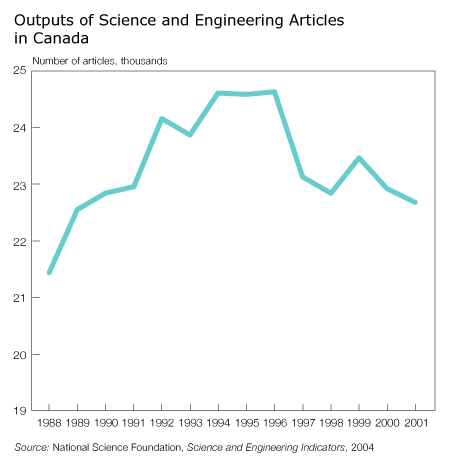
For further information on science and engineering article outputs, see the National Science Foundation report
entitled Science and Engineering Indicators 2004, Volume 2 (http://www.nsf.gov/statistics).
International comparison
OECD studies suggest that an innovation gap separates Canada from the leading OECD countries. The Canada's
Innovation Performance chartáshows that in a number of indicators of innovation performance, Canada is considerably
behind the U.S. and other G-7 countries.

Additional information: The social sciences and humanities
New knowledge takes many forms and is not limited to natural sciences and engineering. Innovative thinking about
society and culture, both past and present, contributes to the understanding of the complexity of Canadian society, and
insights from research in the social sciences and humanities help to improve the well-being of Canadians. For example,
through a better comprehension of relationships, whether between the citizen and the state, within families or across
national boundaries, the delivery of health care, education, or immigration services can be improved. In 2004-05, the
Social Sciences and Humanities Research Council had a grants, fellowships, and scholarships budget of $211.0ámillion to
support innovative thinking about real life issues, including the economy, health, the environment, immigration,
globalization, security, human rights, law, poverty, literature, addiction, and sexuality. (Social Sciences and
Humanities Research Council, 2005)
Additional information on innovation: Commercialization
Building a world-class research environment includes support for the commercialization of research
discoveries-transforming ideas into new products, services, and technologies that generate economic and social
benefits. Universities and hospitals recorded moderate gains in commercializing inventions between 2001 and 2003,
according to preliminary data from the Survey of Intellectual Property Commercialization in the Higher Education
Sector. The number of inventions beginning the commercialization process rose during the two-year period. The
number of invention disclosures was up 7.0áper cent while new patent applications increased 35.0áper cent. During the
same period, income from intellectual property commercialization reached $51.0ámillion, up about 7áper cent. However,
this rate of growth was not as substantial as the 126.0-per-cent gain between 1999 and 2001. (Statistics Canada,
The Daily, Decemberá9,á2004)
Current performance and trends
According to the 2001 Census, 61.0áper cent of Canadians aged 25 to 34 had educational credentials beyond high
school-28.0áper cent had a university education, 21.0áper cent held a college diploma, and 12.0áper cent had trade
credentials. This is a marked increase over a decade earlier when only 49.0áper cent of people in that age category had
credentials past high school.
In 2003, full-year, full-time workers with a university degree earned on average $67,091 compared to $37,840 for
those with only a high school diploma, a difference of $29,251.
(Statistics Canada, 2005)
About two thirds of the new jobs created in Canada will be in management or will require some form of post-secondary
education, from trades certificates to advanced degrees. (Human Resources and Skills Development Canada, 2005)

International comparison
According to the OECD, Canada is the world leader in education when considering the combined proportion of
university and college graduates. In 2002, 42.6áper cent of Canada's population aged 25 to 64 had completed a college
or university education, increasing annually from 29.9áper cent in 1991. Within the rest of the G-7 figures range from
the U.S. with 38.1áper cent to 10.4áper cent in Italy.
Additional information: Educational attainment
According to the OECD, 51.2áper cent of all Canadians aged 25 to 34 had educational credentials beyond high school
in comparison with 32.1áper cent of all Canadians aged 55-64. Differences between tertiary attainment of younger and
older age groups is a measure of progress in the provision of higher education.
Within the age group of 25-34 year olds, 23.0áper cent of males and 29.0áper cent of females in 2002 attained
university and advanced research program levels. Every year since 1998, the proportion of the female population marking
this achievement has been higher than the proportion of the male population.
In 2002, 40.0áper cent of Canadian males aged 25-64 attained tertiary level education while 45.0áper cent of females
reached the same level. (OECD, Factbook 2005: Economic, Environmental and Social Statistics)
Current performance and trends
The 2003 results of the Adult Literacy and Life Skills Survey found that the average literacy score for
Canadians has not changed significantly since the last major survey in 1994, the International Adult Literacy
Survey. During this period, there were significant numbers of adult Canadians with low-level literacy skills that
constrained their participation in society and in the economy. For example, while 58.0áper cent of Canadian adults aged
16 to 65 placed in the top three literacy levels on the prose scale, 15.0áper cent, or over 3ámillion Canadians, scored
on the lowest level, indicating significant problems with dealing with printed materials. Level 3 is considered the
required minimum for successfully functioning within the emerging knowledge society and information economy.

International comparison
Among the seven countries that participated in the 2003 survey, Canada ranked roughly in the middle. On the prose
scale, residents of Norway and Bermuda performed better than Canada whereas Canadian adults performed slightly better
than Americans on all scales.
The 2003 OECD study on the Program for International Student Assessment (PISA) evaluated reading literacy,
mathematics literacy, and science literacy of 15-year-old students in 41ácountries. In reading, the overall achievement
of Canadian students was significantly above the OECD average and only students in Finland outperformed Canadian
students. These results are consistent with those of the 2000 PISA study. Canada also performed well in mathematics and
science, with two countries and four countries respectively outperforming Canada. Where comparisons of the 2000 and
2003 mathematics results are possible (due to refinements in methodology) similar and improving scores were observed.
Lower science performance scores were recorded in 2003 as compared to 2000.
Additional information: Learning a living-Adult Literacy and Life Skills Survey (2003)
Literacy is important to the economic success of both individuals and countries, especially in today's highly
competitive global economy. Countries are moving quickly to raise the literacy levels of their people. At the
individual level, a basic level of literacy is now required to get and keep most jobs and to adjust to changing
economic opportunities. At the national level, it enables a country's workforce to compete in a changing world, opening
the way for economic growth and enhanced quality of life.
Age
According to the Adult Literacy and Life Skills Survey, age and skill level are inversely related, even
once results are controlled for educational attainment. In general, young people performed better than older Canadians.
Once education was taken into account, however, a decline in literacy scores among 16 to 25 year olds from 1994 to 2003
is observed. The decline was primarily in youths from lower socio-economic backgrounds.
Older age groups demonstrated greater variability in literacy scores. One element of the explanation offered by the
Adult Literacy and Life Skills Survey is the interaction of an aging effect (effect of age on attention
capacity, working memory, spatial ability) and a practice effect (the accumulation of knowledge and experience),
together with a range of life experiences. Additional factors to take into account include cohort and period effects:
schooling available to an age group during formative years and how recent the schooling was.
Socio-economic background
In the Adult Literacy and Life Skills Survey, socio-economic background is the represented level of
education and is analyzed using socio-economic gradients that are summarized by education level, slope, and strength of
relationship. A review of research literature by the authors of the Adult Literacy and Life Skills Survey
found that the assertion that parents with higher level of education are advantaged in terms of wealth, prestige,
power, and formation of foundation skills is well accepted.
After the U.S., Canada had steepest socio-economic gradient of countries surveyed. Steepness of slope indicates the
degree to which parents' education level affects their children's literacy achievements. A steeper slope indicates a
greater influence. The Canadian results therefore suggest that youth whose parents have relatively low levels of
education tend to have low literacy skills. The opposite is also true: youth with highly educated parents tend to have
high literacy skills. It is also important to note, however, that there are a significant number of "resilient" youth
in Canada, those with literacy scores at the 4/5 level and parents with lower levels of education.
Gender
Gender-related trends were also observed. Canadian males tended to demonstrate a greater proficiency in numeracy and
document literacy skills while females held the advantage in prose literacy, for both the population aged 16 to 65 and
the population aged 16 to 65 with completed upper secondary education. The Adult Literacy and Life Skills
Survey is cautious in their explanations for gender differences, stating that differences are apparent early in
life, though choices of training and occupation also carry an impact. From a cross-cultural perspective, Norway,
Bermuda, and the U.S. exhibited the same pattern, while Italy, Mexico, and Switzerland did not. In the latter three
countries, males demonstrated greater proficiency than females in all areas of literacy with the exception of prose
literacy for Italian and Mexican women with completed upper secondary education.
- Employment
- Income security
Current performance and trends
Canada experienced employment growth in 2004, with a gain of 226,000 jobs between Decemberá2003 and Decemberá2004,
continuing an upward trend that began in the mid-1990s. This growth helped to push the number of employed relative to
the working-age population (persons 15 and over) to 62.7áper cent for 2004, up from 62.4áper cent in 2003.

Employment: Provincial differences and unemployment rates
Current performance and trends
The Atlantic provinces and Quebec continue to have higher unemployment rates than the national average. The
unemployment rate in BritisháColumbia has surpassed or equalled the national average in each of the last sevenáyears.
Ontario, Manitoba, Saskatchewan, and Alberta had unemployment rates below the national average. Comparing the
unemployment rate of Aprilá2004 to Aprilá2005, improvements are seen for all provinces.

International comparison: Employment growth
Canada has experienced consistent employment growth since the mid-1990s, in contrast with some G-7 countries, such
as Japan and Germany, whose employment growth has been minimal. Between 1997 and 2004, Canada experienced the strongest
growth in employment among the G-7 countries, outperforming for example, the U.S. and the United Kingdom.
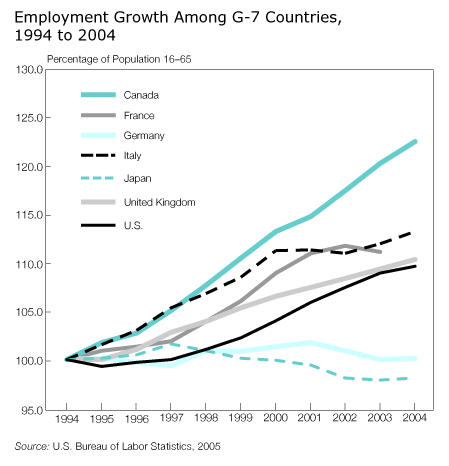
Income security: RDI per capita
Current performance and trends
In 2004, RDI per capita rose 1.5áper cent to $20,780 from $20,475 in 2003. After declining in the first half of the
1990s, RDI per capita has increased at an average rate of 1.7áper cent per year since 1997, reflecting strong
employment growth and cuts in personal taxes. In addition, the 2001 Census indicated increases in overall earnings,
defined here as total wages and salaries plus net income from self-employment.
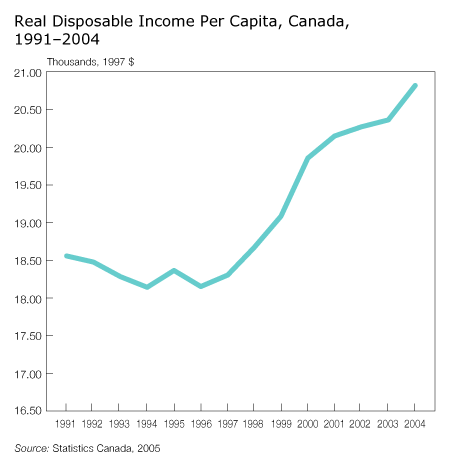
Income security: Canada's low-income situation
Current performance and trends
Despite the strong growth in average incomes, some Canadians still experience economic hardships, living on incomes
insufficient to meet their daily needs or to allow adequate participation in society. While Canada does not have an
official poverty line, low income measures such as Statistic Canada's post-tax low income cutoffs (LICO) are typically
used to measure and monitor Canada's low-income situation.
- In 2003, the LICOs varied from $10,821 for an unattached individual living in a rural area to $43,381 for a family
of seven or more persons living in a large Canadian city.
- The prevalence of Canadians living below the LICOs measure has moved from 13.7áper cent in 1994 to a high of
15.7áper cent in 1996, then down to 11.5áper cent in 2003.
- Low income among seniors has declined significantly, from 21.3áper cent in 1980 to 6.8áper cent in 2003.
- Of the estimated 540,000 single-parent families headed by a woman, 38.4áper cent earned low income in 2003, up from
33.8áper cent in 2001. Their low-income rate peaked at 52.7áper cent in 1996.
- An estimated 11.5áper cent of children, or 843,000 Canadians under the age of 18, were living in low-income
families in 2003. This represents a decline from a peak of 18.6áper cent in 1996.
(Statistics Canada, The Daily, "Survey of Labour and Income Dynamics," 2005)
- Barriers to entrepreneurship
Barriers to entrepreneurship
Current performance and trends
According to the OECD, Canada has developed a strong regulatory capacity that has greatly contributed to Canada's
economic growth. Three areas for measuring the regulatory climate and producing an overall score for barriers to
entrepreneurship are as follows:
- administrative burden on start-ups;
- regulatory and administrative opacity; and
- barriers to competition.
In 2003, Canada had the lowest level of regulatory barriers to entrepreneurship among G-7ácountries, sharing the top
position with the United Kingdom. Canada's overall score has improved from 1998. These low barriers contribute to an
innovative economy and provide an advantage for Canadian entrepreneurs in the global marketplace. According to the
OECD, however, a key priority for Canada should be to reduce barriers to foreign ownership because restrictions are
holding back competition and innovation. (OECD, Product Market Regulation in OECD Countries, 1998 to 2003;
Ibid,Economics Working Paper No. 419, 2005; Ibid, Economic Policy Reforms-Going for Growth, 2005)
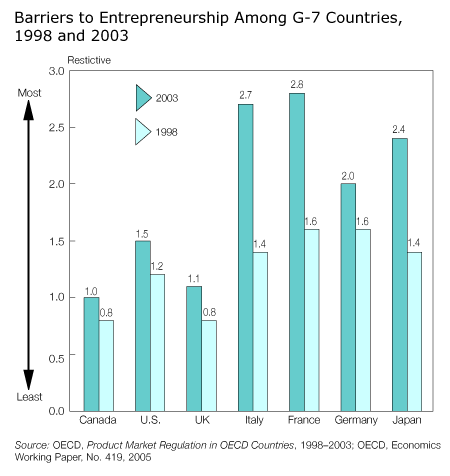
- Air quality
- Water use
- Biodiversity
Current performance and trends
The yearly average concentrations in urban air across Canada of sulphur dioxide (SO2) and nitrogen oxides
(NOx), volatile organic compounds (VOC), and fine particulate matter (PM2.5) have all decreased
overall since the mid- to late 1980s. PM2.5 concentrations have shown incremental increases since 2000.
Ground-level ozone, which had shown increases since the mid-1990s, remained relatively stableábetween 2001 and
2003.
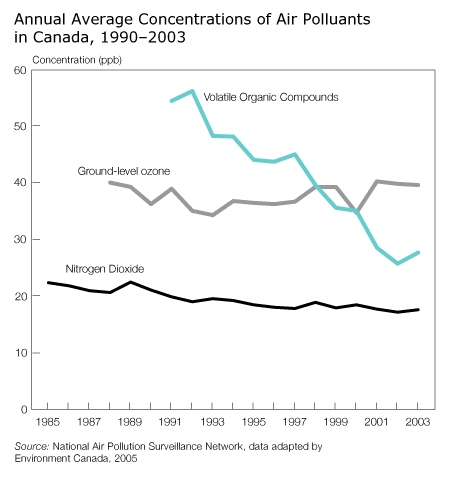

Current performance and trends
Levels of ground-level ozone can vary considerably on an hourly, daily, and monthly basis, depending on the
prevailing meteorological conditions (especially temperature and air stability), the origin of air masses, and
emissions. Since the late 1980s, despite the reductions observed in ambient concentrations of NOx and VOC,
the peak levels of ground-level ozone, averaged across all sites in Canada, have remained relatively stable, though
persistently high. These levels vary across the country. Levels tend to be higher east of the Manitoba-Ontario border,
especially along the Windsor-Quebec City corridor.

For more information, consult the Environmental Technology Centre Webásite, which contains information on
measurement and clean air at http://www.etc-cte.ec.gc.ca/etchome_e.html.
Current performance and trends
In 2001, average residential water use per person was 335.0 litres per day. Water use involves taking water from the
environment as well as returning water to the environment, and as a result a variety of pressures are placed on
Canada's water resources. The quantity of water used is a concern, which includes concern over the capability of
aquatic ecosystems to meet demand during dry periods. Water quality is a related issue of water use due to the
increased use of water treatment chemicals that are subsequently discharged with wastewater.

Non-residential water use
In Canada water use is dominated by agriculture and industry-for example, 64.0áper cent of water use in Canada is
attributed to the flow of water into and out of thermal power plants.
Additional information: Water quality indices
In 2003, a general picture of the overall quality of Canada's freshwater was developed using water quality index
ratings from federal and provincial studies across Canada. Beginning in the late fall of 2005, both the water quality
indicator and the coverage of major Canadian watersheds will be enhanced to support comprehensive annual reporting of
water quality in Canada, under the Competitiveness and Environmental Sustainability Indicators Initiative. While the
first report will focus on protection of aquatic life, other major uses of water such as drinking water, recreation,
agriculture and industry will be built in over time to provide a more complete picture of water quality in Canada and
its links to Canada's society and economy.
Water quality is monitored in lakes and rivers across Canada by federal, provincial, and territorial agencies.
Annual reporting on water quality under the competitiveness and environmental sustainability indicators initiative will
begin in the fall of 2005. The first report will describe a national picture of water quality as it relates to the
protection of aquatic life. Future reports will assess water quality as it relates to other major water uses, namely
source water for drinking, water for recreation, water for agriculture, and water for industrial use.
Current performance and trends
Since 1978, the Committee on the Status of Endangered Wildlife in Canada (COSEWIC) has been assessing and
reassessing the status of Canadian wild species suspected of being at risk.(1) By May 2005, COSEWIC had assessed 687áspecies, 487 of which were determined to be at risk
(extirpated, endangered, threatened, or of special concern). In addition, the total number of extinct species has risen
from 12 to 13 between May 2004 and Mayá2005. A total of 147 species have been reassessed by COSEWIC more than once. Of
these, the status of 42 species worsened (28.6áper cent) whereas 25 species (17.0áper cent) improved, i.e. were
determined to be no longer at risk or placed in a lower risk category. This would seem to illustrate that, despite some
successes, the state of biodiversity overall has deteriorated. As an indicator, however, COSEWIC reassessments offer
only a glimpse of the overall status of biodiversity in Canada. Other indicators are currently under development for
Canada.
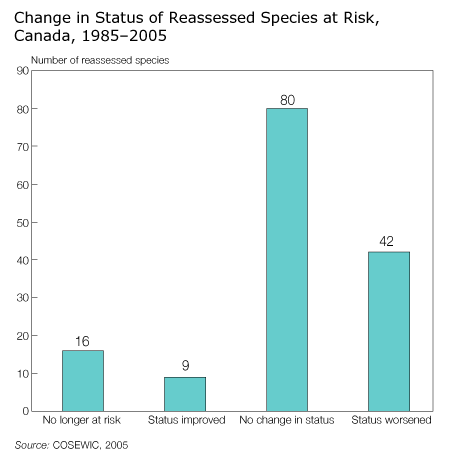
Additional information: Sustainable economic growth
Economic growth and environmental concerns
In Canada, individual lifestyles and the degree to which more environmentally benign technologies are embraced are
as important indicators of environmental stress as is total population. The slight decline in per capita energy use
since 1990, coupled with a significant increase in per capita economic growth, indicates that the Canadian economy is
becoming more energy efficient. There are limitations, however, in the types of measures that illustrate the extent to
which economic activity is affecting the environment. Over the coming years, as better indicators of the relationship
between the economy and the environment are developed, the Government of Canada will be able to track how rapidly
Canada's economy is embracing environmental values and to what degree economic growth is depleting Canada's natural
capital. (Environment Canada, Environmental Signals, 2003)
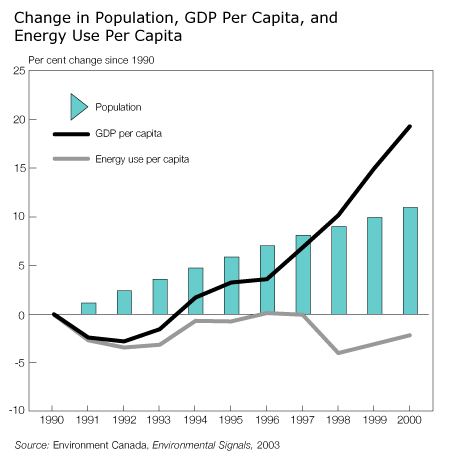
Securing Canada's natural capital
For more information, see the National Round Tableáon the Environment and the Economy publication entitled
Securing Canada's Natural Capital: A Vision for Nature Conservation in the 21st Century (http://www.nrtee-trnee.ca/eng/index_e.htm).
Canada's demographicáchallenge
An aging population will be a key challenge facing the Canadian economy over the coming decade. Currently there are
more than five people of working age for every person of retirement age, and by 2050 the ratio will be less than 2.5 to
1. While this is a worldwide phenomenon that will affect all G-7 countries, Canada will experience one of the largest
increases in the ratio of the elderly to the population aged 15-64 over the next 25 years. Labour scarcity is therefore
an immanent phenomenon and one that requires sustained consideration.
The projected decline in the employment-to-population ratio will gradually become a hindrance to growth in living
standards beyond 2010. Two strategies to deal with the upcoming labour scarcity are the integration of immigrants into
the labour market and assurance that older Canadians do not face disincentives to work. Moreover, improvements in the
living standards of Canadians will increasingly have to rely on productivity growth. Productivity is the amount of
output per unit of input used. Canada must concentrate on the drivers of increased productivity: human capital,
innovation, and physical capital.
The reduction of the public debt burden since 1995-resulting in lower debt charges-has put Canada in a better
position to face emerging demands on social programs, such as health care and universal public pensions, and has
provided more flexibility to deal with emerging demographicáspending pressures. It is estimated that as a result of
demographicáchange, government health care expenditures will increase to 11.2áper cent of GDP by 2050, up from 7.1áper
cent in 2004. Canada's retirement income system, comprised of Old Age Security, Canada Pension Plan and Quebec Pension
Plan, registered retirement savings plans, and registered pension plans, is on solid ground. For example, the 1997
reforms to the Canada Pension Plan have ensured its sustainability for the next 75 years.
|
